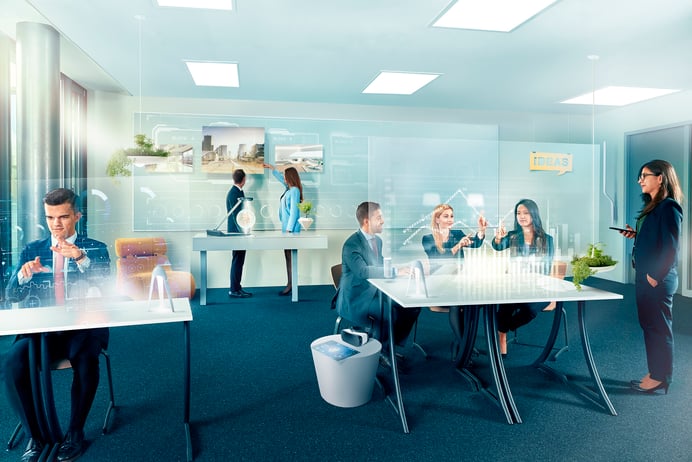Adults in tertiary educational institutions need a well-developed school infrastructure for effective learning, however, many players in the education industry only consider infrastructure as the facilities in schools (like the actual building). But infrastructure in a modern educational institution should now go beyond bricks and mortar, thinking instead in terms of design, environmental and technology. At EHL Advisory Services, we have researched the impacts of school infrastructure on learning and have compiled some essential points that explain the benefits of fully realized learning environments.
Environmental design and academic progress
School infrastructure is what influences student learning so that it can run optimally. According to a study in the UK, colleges and other schools increased students' academic success by 16% after improving design and environmental elements. The improvements focused on stimulation, individualization, and naturalness.
- Stimulation improves school infrastructure by combining different colors and design complexity in classrooms. The perfect blend keeps students interested and focused during lectures. Modern classrooms use colors like orange, yellow and red to create a high-energy learning environment. Other institutions, especially trade and professional schools, use blue, green, or violet in classrooms to create a relaxed learning environment.
- Individualization involves providing flexible learning areas where students can learn one-on-one, study individually, or in groups.
- Naturalness means having as much natural light and air as possible. Artificial light can impede the learning process by causing eye strain and headaches. Equally important are the classroom acoustics that should enhance speech perception and reception, and reduce unnatural auditory disturbances.
INVEST IN EDUCATION TOOLKIT
With this 10-step process, you will have all the tools you need
to master the critical areas of a successful school.
Better infrastructure, less crowded classrooms
Classrooms, colleges and universities today are known to have classes with over 100 students - not simply because a class is very popular or required by many students, but because there is an inadequate amount of classroom space on campus.
When an extremely high number of students are forced into a classroom, the impact on learning is almost always negative. Perhaps the most important negative consequence of large class sizes is a lack of individualized attention for students, especially those who might be struggling. In this case, a lack of personalized attention can result in falling grades, followed by a lack of motivation to continue, ultimately resulting in them dropping out of the class and perhaps school altogether.
Overcrowded classrooms also have a negative impact on teachers. Knowing that they cannot reach students at an optimal level, many teaching professionals just aim for an average mean of impact, hoping that most of their students will succeed with what manages to get through.
Digital infrastructure to improve learning
Research by SMART Technologies—involving about 1227 educators worldwide— shows that schools with robust technological capabilities are ten times more likely to improve student learning outcomes. In the research, 91% of educators with advanced digital infrastructure met or exceeded their teaching goals, while 92% recorded higher test scores among students. On the other hand, 96% of educators improved students' academic success when the educators had access to assessment software to help students with learning, e.g., advanced presentation software, collaborative technology and interactive whiteboards.
As technology revolutionizes the education sector, one of the most significant benefits of digital infrastructure is a school's adaptability. Technology has allowed the education industry to constantly improve and adapt to sudden changes. During the pandemic, virtual learning became the norm so that in today's post-pandemic landscape, students in higher educational institutions can choose between learning online or using hybrid learning that combines in-person and virtual lessons. This streamlines learning possibilities in higher educational institutions.
Many high educational institutions are focusing more on virtual classes because it benefits students with full-time jobs or family responsibilities. Statistics show that nearly 25% of today's college students receive more than 80% of their instructions exclusively via online courses.
School infrastructure: The need for tech upgrades
Technology is evolving fast, and as a result, schools need to upgrade their technology infrastructure to keep up. In a recent study, California's public schools, colleges and universities stated they would need major technological upgrades within the next three years. Many schools said they needed high-density wireless networks and bandwidth as their top-most priorities. Others stated that their biggest technological needs were associated with software and hardware, including:
- Routers
- Network security and firewalls
- Cables
- Switches
In the coming years, schools across the U.S will aim for 100 kbps per student as the minimum connection speed and a ten times faster eventual target speed of 1000kbps. The following benefits explain the importance of infrastructure upgrades in schools.
Increased research and communication
With an improved school tech infrastructure, communication and research capabilities are shared and streamlined among students. Research says that 39% of college students with access to high-speed internet participate in online discussions, while 40% post or share their work on websites. Ironically, in the virtual world, the interconnectedness between students and their methods of working is enhanced by shared drives, online
Multiple learning styles
Improved school infrastructure allows institutions to accommodate multiple learning styles. Some people are auditory learners while others are visual; other students are tactile learners, meaning they depend on active learning techniques that include a sense of touch. Whether it's a PowerPoint presentation for a visual learner, good classroom audio quality or a hands-on lesson with a tablet for a tactile learner, it begins with the school investing in its digital infrastructure.
Instant teacher feedback
In an overcrowded classroom, it's difficult for teachers to know which students are struggling academically or moving forward as expected. With improved school infrastructure, students can easily give teachers feedback due to a streamlined feedback channel between teachers and students. For instance, teachers can comment about students' academic performance through audio and video files. Alternatively, they can easily respond to polls or discuss academic questions in real-time. This improves the learning process since teachers can easily address academic problems before a student's grades falter.
Upgrading technological infrastructure in schools isn't cheap. But doing so allows schools and their students to enjoy many benefits. It streamlines and enhances the learning outcomes so that students have a higher rate of success and can easily move on to new career horizons.
Source: The Impact of School Infrastructure on Learning - The World Bank Group





